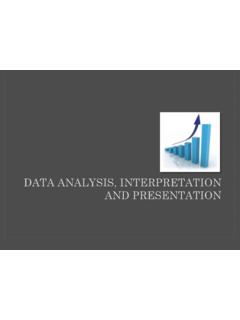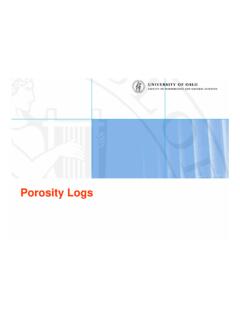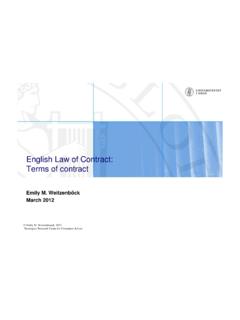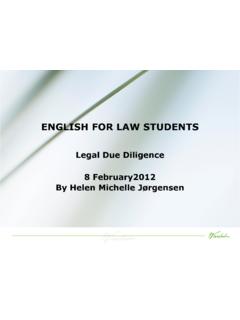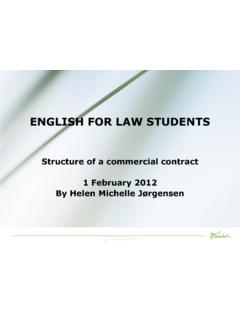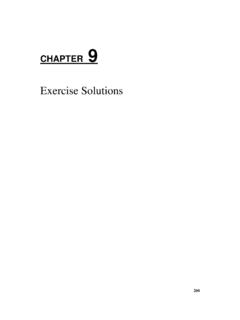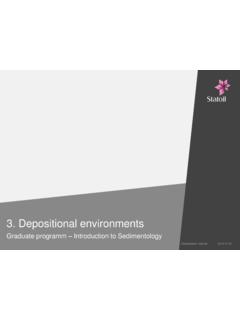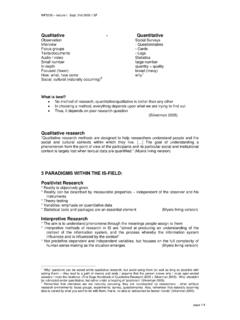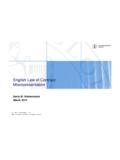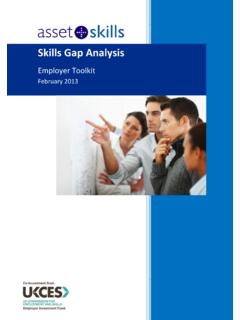Transcription of Chapter 11 Cost benefit analysis - UiO
1 Lecture 6 ECON4910 Environmental Economics Previous lectures: How to solve an environmental externality cost effectiveness Different types of pollution Different types of instruments Taxes, quotas, lisences, subsidies, bargaining Public goods and services implies missing markets Market failure: negative externalities are not corrected or taken into account when the market value is missing for these goods Econ 4910 Spring 2016 Ingrid Hjort This lecture: Ch. 11 cost - benefit analysis How to choose between different investment projects, a tool for decision making Ch. 12 Valuing the environment How to measure and incorporate the natural environment in cost - benefit analysis Ch. 13 Irreversibility, risk and uncertainty How can we handle uncertainties and the risk of irreversible outcomes in cost - benefit analysis Chapter 11 cost - benefit analysis cost - benefit analysis Definition: cost benefit analysis (CBA) is a systematic approach to estimate the short and long term consequences measuring all costs and all possible profits and benefits from an investment project proposal taking into account both quantitative and qualitative factors sometimes called benefit cost analysis (BCA) CBA, is the social evaluation of marginal projects, correcting for a potential market failure ECBA.
2 Environmental impacts of projects/policies are often externalities, both negative and sometimes positive CBA seeks to attach monetary values to external effects so that they can be taken account of, along with the effects on ordinary inputs and outputs How shall the regulator / the policy makers rank different investment projects? Economists: Follow the efficiency criteria Choose the most cost efficient project Example: Consider a fjord in Norway, the F rde fjord, with a small local community. There are scare local labor opportunities, and the regulator want to support industry that create job opportunities, maintaining the local life of its citizens. Consider a case where the local cornerstone company in the fjord is a mining industry. To expand and create job opportunities the industry need permission to dump mineral waste into the fjord. A cheep and easy solution benefitting the economic activity in the area.
3 However, this would have future consequences for the fishing industry and the local ecosystem in the fjord The consequences of dumping mineral waste into the fjords Source: The Norwegian institute of marine research What should the regulator do? Let an independent and neutral party, the analyst in the Norwegian Environmental Agency, perform a cost - benefit analysis , comparing the The economic benefits of establishing a local industry The future environmental damages to the ecosystem and biodiversity The decision and consideration is a political task How should one incorporate the environmental and biological consequences of F rde fjorden in a CBA? Problem: The market do not provide any direct information about the valuation on changes in the provision of environmental goods and services. The environment is a public good without a market, such that there do not exist any market prices. How do one perform environmental valuation?
4 How do one calculate the price of a clean fjord? A simple definition of a CBA Challenging aspects What is the projects time horizon? it might be infinite How do we measure agent s willingness to pay for goods and services without market prices? Who are the relevant agents? should we gather and count every affected agent, what about the valuation of non-users? How do we sum net benefits and the willingness to pay for public goods? The dynamic aspect When comparing projects that involve different people living in different time periods Challenges: Will preferences stay the same over time and across generations? If there are less healthy environment in the future, will they value a stable climate and a rich biodiversity more than us? How much richer/poorer will the future generations be? Should we employ expensive mitigation investments today when future generations probably have better technology and are richer than us?
5 How to evaluate future benefits and costs? These decisions depends our choice of discount rate. For long-lived stock pollution, such as climate change, the choice of policy is extremely sensitive to the choice of discount rate. The dynamic aspect Given that CBA is concerned with consequences over time, and based in welfare economics, a key idea is intertemporal efficiency Social welfare functions For an individual the marginal rate of substitution determines the net willingness to pay. Can we then interpret a welfare change as the aggregate marginal willingness to pay? only if we assume that everyone has the same marginal utility of the numeraire good. Further reading: Brekke, Kjell Arne. 1997. The numeraire matters in cost - benefit analysis . Journal of Economic Literature. 64(1): 117-123. Nyborg, Karine. 2014. Project evaluation with democratic decision making: What does cost - benefit analysis really measure?
6 Memorandum 08/2014, Department of Economics, Oslo Nyborg, Karine. 2000. Project analysis as input to public debate: Environmental valuation versus physical unit indicators. Ecological Economics 34 (3), 393-408 The dynamic aspect Environmental CBA Choice of discount rate Time Horizon Years Discount rate % 25 50 100 200 2 7 The table present a value of $100 in the future at various discount rates At high discount rates the value diminishes and becomes negligible Academic debate: Stern vs Nordhaus The academic disagreement on discount rates is not only arguments about empirical matters, but major debates on conceptual issues. Professor Nicholas Stern and Professor Simon Dietz (Grantham and LSE) The discount rate are based on ethical considerations, weighs the welfare interests of present and future generations, taking into account the risk of catastrophes Not based on individual market behavior, but how societies should behave The Stern Review (2007) Average discount rate for climate change damages is approximately Professor William Nordhaus (Yale University) Uses a discount rate consistent with today s marketplace real interest rates and savings rates (the opportunity cost of capital, reflecting the rate at which people are willing to exchange current for future consumption) Directly connected to actual market behavior, can be empirically estimated Developed the computer-based climate model DICE (1993)
7 Uses a discount rate around The discount rate has implications for how aggressive recommended climate policy should be Is there here a groundbreaking interpretable difference, between finding the ideal and actual policy to the moral acceptable and desirable policy. Objections to environmental cost - benefit analysis CBA is based in welfare economics which is consequentialist and subjectivist, essentially it accepts that the natural environment should be subject to consumer sovereignty Consumer sovereignty can be rejected as a proper guide on the grounds of inadequate information about consequences insufficiently deliberative lacking self-knowledge preference shaping Do we accept that only human interests count? Or should we take into account the interests of other living entities Does the valuation methods actually deliver the necessary information? There is no guarantee that the subjective assessment of their utility losses by individuals will be large enough to stop a project that threatens sustainability.
8 ECBA should therefore be restricted in its application Chapter 12 Valuing the environment International Initiative TEEB: The Economics of Ecosystems and Biodiversity, launched by the European Commission in 2007 Global initiative focused on making nature s values visible Mainstream the values of biodiversity and ecosystem services into decision-making at all levels Motive: establish an objective global standard basis for natural capital accounting Estimate: The costs of ecosystem damage are expected to be 18% of global economic output by 2050 Norway s initiative NOU 2013:10. Naturens goder om verdier av kosystemtjenester. Norges offentlige utredninger. Milj verndepartementet, Oslo. Norwegian Pollution Control Authority, 2010. Verdsetting av marine kosystemtjenester: Metoder og eksempler. Norwegian Environmental Agency, Oslo Kostnadsberegningsutvalget. 1997. Nytte-kostnadsanalyser. Prinsipper for l nnsomhetsvurderinger i offentlig forvaltning.
9 FIN, NOU 1997:27, Oslo Purposes of environmental valuation Inclusion of environmental impacts in cost benefit analysis of projects/policies Determination of targets for environmental quality standards Accounting for environment impacts in measuring national economic performance In the USA, fixing compensation by those the courts hold responsible for environmental damage Valuing the environment Valuation in theory: Environmental benefits /damages should be valued as the marginal willingness to pay or the marginal willingness to accept Valuation in practice: 5 techniques Stated preference method: our preferences over nature valuation (CV) Revealed preference methods: our use of nature experiments travel cost method (TC) pricing function-based techniques Categories of environmental benefits Use Non-use Consumptive Non-consumptive Existence Altruistic Bequest Revealed preference methods Stated preference methods Indirect use carbon fixation, micro-climate regulation Total economic value Environmental valuation theory How to find monetary measures for environmental quality changes Two approaches Willingness to pay (WTP) The amount you are willing to pay for an improvement in environmental quality Willingness to accept (WTA) The compensation you accept for a reduction in environmental quality WTP is constrained by the individual's budget, WTA is not bounded by income Assume that quantity/quality of an environmental good (e) can be treated as an argument in a well-behaved utility function Where (y) is income (expenditure on all private goods)
10 And the environmental quality (e) cannot be individual chosen Compensating surplus (CS) Equivalent surplus (ES) Improvement WTP for the change occurring WTA compensation for the change not occurring Decline WTA compensation for the change occurring WTP for the change not to occur e0 e1 At A, WTP for e improvement = BC is the Compensating Surplus At A, WTA in lieu of e improvement = DA is the Equivalent Surplus e1 e0 At B, WTP to avoid deterioration = BC is the Equivalent Surplus At B, WTA compensation for decline = DA, is the Compensating Surplus 1. Contingent valuation Survey-based valuation technique Which involves asking a representative sample about their WTP or their WTA for environmental goods and services. Revealed preference method Best suited for capturing use-values Application: benefits of improving air/water quality benefits of wilderness areas benefits of outdoor recreation opportunities The steps involved in conducting a CV study: a survey (questionnaire) Explain the purpose of the exercise, Describe the problem, Questions about respondent s knowledge and attitudes, Statement of payment vehicle, Reminders about substitutes and income constraints, Ask about WTP Different methods produce different results, Open ended: ask what is your maximum WTP Avoids giving respondents cues, but difficult for them Bidding game: the respondent is asked if WTP a sequence of increasing amounts until says no.
